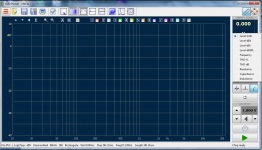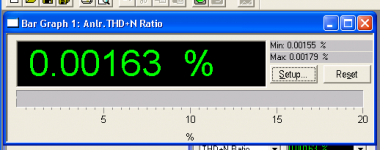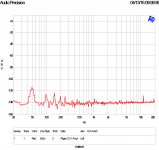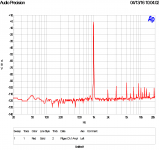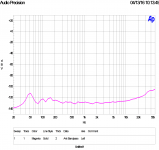See AudioXpress December 2015 for a direct comparison between the CLIO Pocket and ARTA plus a soundcard.
SY, you have successfully motivated me to subcribe to AX.
hello panson_hk, you have some information about mesurement distortion in clio pocket?
Spectrum measurement has good resolution, but frequency vs distortion is more transparent.
But without reservations, calibration for absolute SPL is in Clio best.
Current CLIO Pocket software shows THD as numbers instead of curves. This is less useful than that of REW and ARTA. CLIO Pocket also uses logchirp to measure frequency response. Distortion information is indeed available in the processed signal. I wonder why they don't show it. They may don't want the software to be too "powerful" in order not to adversely affect the full-featured CLIO market.
Attachments
I have a calibrated mic sitting next to me for a few months,
yet I have not started to use REW.
Due to my experience with ARTA (with e-MU 0404 and RME AIO),
I started to wonder whether it is better for me
to buy integrated products like CLIO pocket and QA401
instead of using a soundcard + freeware for measurement purposes.
It saves time. I want something convenient and functional.
Functionally, I guess CLIO, ARTA and REW are more or less the same.
You may need a mic amp for QA401. Can it be EMU0404?
I wish Audiomatica will enhance (add more features) the CLIO Pocket software. Signal is captured already. It is just a matter of software processing.
Hi Arthur,
I didn't know about clio pocket whether .wav file can be imported.So if you got the time,you could make some comparisons between them on the CSD functionality.
Best
Unfortunately, CLIO Pocket can only import text file. Let me see if I can observe the difference between REW and ARTA as you found.
I wish Audiomatica will enhance (add more features) the CLIO Pocket software.
I wish too : http://www.diyaudio.com/forums/equipment-tools/289397-clio-pocket-clio-lcr-meter.html#post4670563
You may need a mic amp for QA401. Can it be EMU0404?
I wish Audiomatica will enhance (add more features) the CLIO Pocket software. Signal is captured already. It is just a matter of software processing.
Nope. I got me emu0404 burnt after a modification of the ADC circuit.
The calibrated mic is a superlux ecm999 which is connected to REW with Shure X2U.
Just a few AP-S1 measurements of my CLIO Pocket.
AP-S1 sampling frequency was 48 kHz. AUX input was connected to CLIO Pocket output.
The bar shows THD+N of 1 kHz, 1 V output.
Right most figure shows background noise level measured by using bandpass filter of AP.
AP-S1 sampling frequency was 48 kHz. AUX input was connected to CLIO Pocket output.
The bar shows THD+N of 1 kHz, 1 V output.
Right most figure shows background noise level measured by using bandpass filter of AP.
Attachments
Just a few AP-S1 measurements of my CLIO Pocket.
AP-S1 sampling frequency was 48 kHz. AUX input was connected to CLIO Pocket output.
The bar shows THD+N of 1 kHz, 1 V output.
Right most figure shows background noise level measured by using bandpass filter of AP.
Very good result. Few sound card in the normal value has such a solid parameters
Just a few AP-S1 measurements of my CLIO Pocket.
AP-S1 sampling frequency was 48 kHz. AUX input was connected to CLIO Pocket output.
The bar shows THD+N of 1 kHz, 1 V output.
Right most figure shows background noise level measured by using bandpass filter of AP.
Hi,Panson
Thanks for your kind response!Today I find out that something interesting in REW and Arta.
First of all,all kinds of functions that I test between them indeed the same outcome and get the identical result.
Whilst I feel that REW outperforms Arta at some extent including data interchange,fast SPL calibration,data curves comparisons and the unique wavelet transformation.However,I realize that one display parameter should be been pointed out,that’s the RMS input level in the RTA spetrum.In REW it seems that 3dBFs higher than Arta if you feed the same signal level into them and make comparisons(I use an additional signal generator rather than the one into them providing the identical source entirely,take a measurement of the 6” monitor box with the nearfield method and keep all the conditions equivalent ) .Furthermore I also perform an another experimentation with the soundcard loopback testing.The results list below,please take notice of the RMS level displayed
Something weird?Disregard the RMS value ,THD and THD+N make no difference nearly.Maybe several checkouts can make it come out. Whereas it’s still a very good and excellent measurement tool.
Thanks for reading!
Attachments
This is probably due to the REW and ARTA defining the dBFS in different ways.
See here
a) RMS value of a full-scale square wave is designated 0 dBFS, all possible dBFS measurements are negative numbers. A sine wave could not exist at a larger RMS value than −3 dBFS without clipping,
b) RMS value of a full-scale sine wave is designated 0 dBFS, a full-scale square wave would have an RMS of +3 dBFS
This is usually what explains the 3dB difference between measurement systems.
Meaning that you can test this out if you feed in a signal that is just below clipping and see what value each system gives you...
See here
a) RMS value of a full-scale square wave is designated 0 dBFS, all possible dBFS measurements are negative numbers. A sine wave could not exist at a larger RMS value than −3 dBFS without clipping,
b) RMS value of a full-scale sine wave is designated 0 dBFS, a full-scale square wave would have an RMS of +3 dBFS
This is usually what explains the 3dB difference between measurement systems.
Meaning that you can test this out if you feed in a signal that is just below clipping and see what value each system gives you...
Good job,one should pay attention to the 3dB difference to the signal feeding into the system!Note also test the voltage before making measurement.As long as the same amplitude the signal is,the same result regardless of what the RMS value shows.This is usually what explains the 3dB difference between measurement systems.
Thanks for your reply!
Hi,Panson
Thanks for your kind response!Today I find out that something interesting in REW and Arta.
Thanks for sharing your interesting data. I remember there is some differences in octave smoothing implementation as well.
I remember there is some differences in octave smoothing implementation as well.
A few months ago,I had asked for help about this question from its software programmer Ivo.He said that arta utilized the same algorithm with MLSSA in contrast to REW which employed the similar processing algorithm most plateforms do.REW always fits the common visual requirement.
Best
This morning another confirmation makes here.Just remember the signal generator should attenuate 3dB before THD measurement then will obtain the same outcome.Under this circumstance the RMS level in REW show 3dB lower than Arta.That's it!
Attachments
Last edited:
My CLIO pocket has been working in my lab for over two weeks. It is a nice speaker measurement tool. I used the bigger brother CLIO-FW before. Its firewire interface was not stable. Pocket uses USB and does not need an external DC supply. I have not encountered any connection problem. I also like its software supporting Windows and OSX!
The software does not have those advanced features of CLIO-11. But it is sufficient for my driver/enclosure measurement. One drawback is that it can not open MLS, SIN files saved by CLIO-11. On the other hand, I can export measured data to text file (impedance, frequency data) and wav file (time data). These export files can be processed by other tools like REW. I can use REW to calculate TS parameter to compare with CLIO pocket derived parameters. REW can show us how good the model fits the measured data.
I can also import impulse response (wav file) to REW. The impulse response can then be windowed by different window functions whereas Pocket software has just rectangular or half-hann windows. REW also allows more control on waterfall display. Spectrogram can also be generated.
Please , do you know some measurements bass reflex and speaker?
Thank you
Do you mean how to measure a bass reflex-enclosure? I do near-field and far-field SPL. You can find a useful app note (http://www.audiomatica.com/wp/wp-co...Loudspeakers-at-low-Frequencies-with-CLIO.pdf) for near-field approach at Audiomatica (CLIO vendor). Near-filed is used to measure low-freq. in typical living environments. Time-gated far-field is used to measure mid-high freq. We splice both measured data to form a full bandwidth freq. response.
Good job,one should pay attention to the 3dB difference to the signal feeding into the system!Note also test the voltage before making measurement.As long as the same amplitude the signal is,the same result regardless of what the RMS value shows.
Thanks for your reply!
I don't think it is a different level into the system, it is referenced differently to 0dBFs. No?
Jan
I don't think it is a different level into the system, it is referenced differently to 0dBFs. No?
Jan
Both the levels are the same in dB which can be tested with SPL meter for confirmation,just REW looks upon the clipping level as -3dB around as some soundcards may cause clipping!
Do you mean how to measure a bass reflex-enclosure? I do near-field and far-field SPL. You can find a useful app note (http://www.audiomatica.com/wp/wp-co...Loudspeakers-at-low-Frequencies-with-CLIO.pdf) for near-field approach at Audiomatica (CLIO vendor). Near-filed is used to measure low-freq. in typical living environments. Time-gated far-field is used to measure mid-high freq. We splice both measured data to form a full bandwidth freq. response.
I mean in Clio Pocket and yes measure a bass reflex enclosure.
Paper about MIB i know, but if I could see those charts would help me.
MIB is postprocessing in Clio Pocket ?
Thank
- Home
- Design & Build
- Equipment & Tools
- CLIO Pocket
